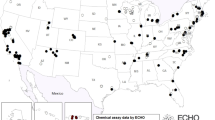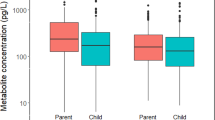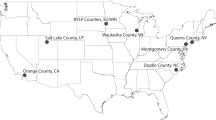Abstract
The School Health Initiative: Environment, Learning, Disease (SHIELD) study, the Minnesota Children's Pesticide Exposure Study (MNCPES), and the National Cooperative Inner-City Asthma Study (NCICAS) are three of the most intensive and invasive exposure-monitoring projects ever undertaken in children. An intrinsic facet of each study was the need to recruit children and their families, retain them for the duration of the project, and ensure that they completed monitoring protocols successfully. All of the studies used fiscal incentives to encourage participation, retention, and compliance. Recruitment rates varied from 40% in MNCPES, to 57% in SHIELD, to 64% in NCICAS, while retention rates varied from 85% in SHIELD, to 94% in MNCPES, to 95% in NCICAS. Rates of compliance with exposure sampling procedures were typically >80% for each study. For example, ≥85% of the enrolled children provided all requested urine samples (1 for NCICAS, 2 for SHIELD, 3 for MNCPES), and 82% of the children in SHIELD provided two out of two blood samples (optional in MNCPES and NCICAS). However, compliance rates were substantially lower (34% SHIELD, 40% NCICAS, not applicable to MNCPES) for the more complex and time-consuming protocol used to collect peak flow data. Overall, results demonstrate that it is practical and affordable to conduct demanding exposure-monitoring studies in children, including children from poor minority communities.
This is a preview of subscription content, access via your institution
Access options
Subscribe to this journal
Receive 6 print issues and online access
$259.00 per year
only $43.17 per issue
Buy this article
- Purchase on Springer Link
- Instant access to full article PDF
Prices may be subject to local taxes which are calculated during checkout
Similar content being viewed by others
References
Adgate J.L., Clayton C.A., Quackenboss J.J., Thomas K.W., Whitmore R.W., Pellizzari E.D., Lioy P.J., Shubat P., Stroebel C., Freeman N.C.G., and Sexton K. Measurement of multi-pollutant and multi-pathway exposures in a probability-based sample of children: practical strategies for effective field studies. J Expos Anal Environ Epidemiol 2000: 10 (6): 650–661.
Adgate J.L., and Sexton K. Children's exposure to pesticides in residential settings. In: R. Krieger (Ed.). Handbook of Pesticide Toxicology. Academic Press, San Diego, CA, 2001, pp. 887–904.
Armstrong T.W., Hushka L.J., Tell J.G., and Zaleski R.T. A tiered approach for assessing children's exposure. Environ Health Perspect 2000: 108 (6): 469–474.
Callahan M.A., Clickner R., Whitmore R.W., Kalton G., and Sexton K. Overview of important design issues for a national human exposure assessment survey. J Expos Anal Environ Epidemiol 1995: 5 (3): 257–282.
Carlson J.E. Children's environmental health: research, practice, prevention and policy. Environ Health Perspect 1998: 106 (Suppl. 3): 785–862.
Clinton W.J. Executive Order 13045. April 21, 1997. The protection of children to environmental risks and safety risks. Fed Reg 1997: 62: 19885–19888.
Environmental Protection Agency (EPA). Strategy for Research on Environmental Risks to Children, EPA/600/R-00/068, Office of Research and Development, Washington, DC, 1999.
Fitzgibbon M.L., Prewitt T.E., Blackman L.R., Simon P., Luke A., Keys L.C., Avellone M.E., and Singh V. Quantitative assessment of recruitment efforts for prevention trials in two diverse black populations. Prev Med 1998: 27: 838–845.
Galson S.K. Preventable causes of cancer in children. Environ Health Perspect 1998: 106 (Suppl. 3): 865–925.
Hubal E.A.C., Sheldon L.S., Burke J.M., McCurdy T.R., Berry M.R., Rigas M.L., Zartarian V., and Freeman N.C.G. Children's exposure assessment: a review of factors influencing children's exposure and the data available to characterize and assess that exposure. Environ Health Perspect 2000: 108 (6): 475–486.
Janson A.S., Alioto M.E., and Boushey H.A. Attrition and retention of ethnically diverse subjects in a multicenter randomized controlled research trial. Control Clin Trials 2001: 22: 236S–243S.
Julion W., and Gross D. Recruiting families of color from the inner city: insights from the recruiters. Nurs Outlook 2000: 48 (5): 230–237.
Landrigan P.J., and Carlson J.E. Environmental policy and children's health. Future Child: Critical Issues Child Youths 1995: 5 (2): 34–52.
Landrigan P.J., Weiss B., Goldman L.R., Carpenter D.O., and Suk W.A. The developing brain and the environment. Environ Health Perspect 2000: 108 (Suppl. 3): 373–597.
Mukerjee D. Assessment of risk from multimedia exposures of children to environmental chemicals. J Air Waste Mngt Assoc 1998: 48: 483–501.
Mitchell H., Senturia Y., Gergen P., Baker D., Joseph C., McNitt-Mortimer K., Wedner H.J., Crain E., Eggleston P., Evans R., Kattan M., Kercsmar C., Leickly F., Malveaux F., Smartt E., and Weiss K. Design and methods of the National Cooperative Inner-City Asthma study. Ped Pulmon 1997: 24: 237–252.
National Research Council (NRC). Pesticides in the Diets of Infants and Children. National Academy Press, Washington, DC, 1993.
National Children's Study Interagency Coordinating Committee (NCSICC). The national children's study of environmental effects on child health and development. Environ Health Perspect 2003: 111 (4): 642–646.
Needham L.L., and Sexton K. (Eds.) Assessment of children's environmental exposure. J Expos Anal Environl Epidemiol 2000a: 10 (6): 611–815.
Needham L.L., and Sexton K. Assessing children's exposure to hazardous environmental chemicals: an overview of selected research challenges and complexities. J Expos Anal Environ Epidemiol 2000b: 10 (6): 611–629.
Preloran H.M., Browner C.H., and Lieber E. Strategies for motivating Latino couples' participation in qualitative health research and their effects on sample construction. Am J Pub Health 2001: 91: 1832–1841.
Pletsch P.K., Howe C., and Tenney M. Recruitment of minority subjects for intervention research. Image 1995: 27 (3): 211–215.
Pressel S., Davis B.R., Louis G.T., Whelton P., Adrogue H., Egan D., Farber M., Payne G., Probstfield J., and Ward H. Participant recruitment in the antihypertensive and lipid-lowering treatment to prevent heart attack trial (ALLHAT). Control Clin Trials 2001: 22: 674–686.
Senturia Y.D., McNiff-Mortimer K., Baker D., Gergen P., Mitchell H., Joseph C., and Wedner H.J. Successful techniques for retention of study participants in an inner-city population. Control Clin Trials 1998: 19: 544–554.
Sexton K. Sociodemographic aspects of human susceptibility to toxic chemicals: do class and race matter for realistic risk assessment? Environ Tox Pharm 1997: 4 (3–4): 261–269.
Sexton K., Greaves I.A., Church T.R., Adgate J.L., Ramachandran G., Tweedie R., Fredrickson F., Geisser M., Sikorski M., Fischer G., Jones D., and Ellringer P. A school-based strategy to assess children's environmental exposures and related health effects in economically disadvantaged urban communities. J Expos Anal Environ Epidemiol 2000: 10 (6): 682–694.
Sexton K., Adgate J.L., Church T.R., Greaves I.A., Ramachandran G., Fredrickson A.L., Geisser M.S., and Ryan A.D. Recruitment, retention, and compliance results from a probability study of children's environmental health in economically disadvantaged neighborhoods. Environ Health Perspect 2003: 111 (5): 731–736.
Sexton K., Adgate J.L., Church T.R., Hecht S.S., Ramachandran G., Greaves I.A., Fredrickson A.L., Ryan A.D., Carmella S.G., and Geisser M.S. Children's exposure to environmental tobacco smoke: using diverse exposure metrics to document ethnic/racial differences. Environ Health Perspect 2004: 112 (3): 392–397.
Sorkness C.A., Ford J.G., and Leanske R.F. Recruitment strategies in the Asthma Clinical Research Network. Control Clin Trials 2001: 22: S222–S235.
Acknowledgements
This work was funded in part by two Science to Achieve Results (STAR) Grants, R825813 and R826789, from the US Environmental Protection Agency, National Center for Environmental Research.
Author information
Authors and Affiliations
Corresponding author
Rights and permissions
About this article
Cite this article
Sexton, K. Comparison of recruitment, retention, and compliance results for three children's exposure monitoring studies. J Expo Sci Environ Epidemiol 15, 350–356 (2005). https://doi.org/10.1038/sj.jea.7500410
Received:
Accepted:
Published:
Issue Date:
DOI: https://doi.org/10.1038/sj.jea.7500410
Keywords
This article is cited by
-
Recruitment and Retention of Children in Behavioral Health Risk Factor Studies: REACH Strategies
International Journal of Behavioral Medicine (2014)
-
Using exposure biomarkers in children to compare between-child and within-child variance and calculate correlations among siblings for multiple environmental chemicals
Journal of Exposure Science & Environmental Epidemiology (2012)
-
Differential Access to Digital Communication Technology: Association with Health and Health Survey Recruitment within an African-American Underserviced Urban Population
Journal of Urban Health (2011)
-
Recruitment and retention strategies and methods in the HEALTHY study
International Journal of Obesity (2009)
-
Issues in Design and Implementation in an Urban Birth Cohort Study: The Syracuse AUDIT Project
Journal of Urban Health (2006)



